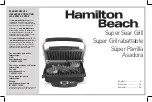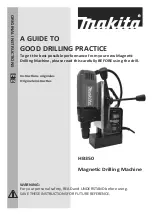
LEAK TESTING
General Information
Although all gas connections on the grill are leaked tested at the factory prior to shipment, a complete gas
tightness check must be performed at the installation site due to possible mishandling in shipment, or
excessive pressure unknowingly being applied to the unit. Periodically check the whole system for leaks, or
immediately check if the smell of gas is detected.
Before Testing
Do Not smoke while leak testing. Extinguish all open flames. Never leak test with an open flame.
Mix a solution of equal parts mild detergent or liquid soap and water.
Testing
1.
Turn off the burner control knobs.
2.
Turn the top knob of the fuel supply cylinder counterclockwise (right to left) one rotation to
open.
3.
Apply the soap solution to connections of the fuel supply assembly. If no soap bubbles
appear, the grill is ok to use. If bubbles form at the connections, a leak is detected.
(If a leak is detected, immediately turn off the gas supply, tighten any leaking fittings, turn gas on,
and recheck).
4.
Turn off the knob on the fuel supply cylinder.
5.
Turn on the burner control knobs for a moment to release the pressure in the hose, then turn
the control knobs back off.
6.
Wash off soapy solution with cold water and towel dry.
Check all gas supply fittings before each use and each time the gas supply cylinder is connected to the regula-
tor. Have a Qualified Service Technician leak test the grill any time a part of the gas system is replaced. Also
have a Qualified Service Technician perform a leak test at least once a year whether or not the L.P. gas supply
cylinder has been disconnected.
10
Note:
If you cannot stop a gas leak turn off the gas supply and call your local gas
utility, or the dealer you purchased the appliance from. If necessary, replace the
faulty part with a manufacture recommended replacement part.





































